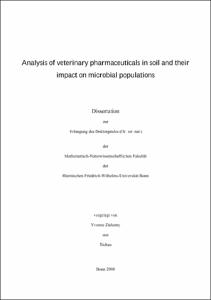Online-Ausgabe in bonndoc: https://nbn-resolving.org/urn:nbn:de:hbz:5N-14206
urn: https://nbn-resolving.org/urn:nbn:de:hbz:5N-14206,
author = {{Yvonne Zielezny}},
title = {Analysis of veterinary pharmaceuticals in soil and their impact on microbial populations},
school = {Rheinische Friedrich-Wilhelms-Universität Bonn},
year = 2008,
note = {
Veterinary medicines may enter agricultural soils by the use of animal excrements as fertilizers. In this study the impact of veterinary pharmaceuticals sulfadiazine (SDZ) and chlortetracycline (CTC) on soil bacterial communities was investigated. Additionally the SDZ concentration in the soil was analysed. Microcosms containing two sorts of agricultural soils, orthic luvisol and gleyic cambisol were used. The soils were spiked with the antimicrobial agents SDZ and CTC at three different concentrations (1, 10, 50 mg/kg) and incubated for 48 or 64 days at 20 °C. SDZ and the metabolite acetyl-SDZ were extracted from the aged soil samples using pressurized liquid extraction (PLE). Acetonitrile/water (80:20 v/v) at 100 °C was chosen as the extraction mixture, solid-phase extraction (SPE) or other clean-up of the samples was not necessary. The quantification was conducted using LCMS/MS with electro spray ionisation (ESI). The recovery rates were between 82.5% and 87%. SDZ dissipated very rapidly and strongly time-dependent from both soils. Furthermore, the impact on the microbial respiratory activity was measured continuously in a respirometer (Sapromat). Changes in bacterial community structure were visualized by means of PCR-denaturing gradient gel electrophoresis (DGGE) of 16S rDNA derived from the soil samples. Additionally, growth inhibitory effects of SDZ and CTC were tested in agar diffusion tests. In microcosms with soil and antibiotics only, no effects could be observed, either on respiratory activity or on bacterial population structure. Therefore, further incubations were conducted in the presence of an additional assimilable carbon source. In the presence of glucose, SDZ affected soil respiration as well the bacterial community structure: additional bands appeared and some bands already visible at the beginning of incubations increased in intensity. A clear relationship between SDZ concentrations and changes in DGGE patterns became visible. During 48 days of incubation, changes in DGGE patterns were minimal in microcosms with 50 mg SDZ/kg soil indicating an inhibition of strains, which were capable of growing on glucose in the presence of lower SDZ concentrations. Only a few soil bacterial isolates were weakly inhibited by SDZ in agar diffusion disk test. Contrastingly, CTC significantly inhibited growth of 12 soil bacterial isolates in disk tests, but no effects on soil respiration and bacterial community structure could be observed. In the presence of the soil matrix the growth inhibitory potential of CTC decreased due to adsorption or complexation. This was confirmed in growth inhibition experiments with soil suspensions and time-dependent sampling.
},url = {https://hdl.handle.net/20.500.11811/3612}
}






